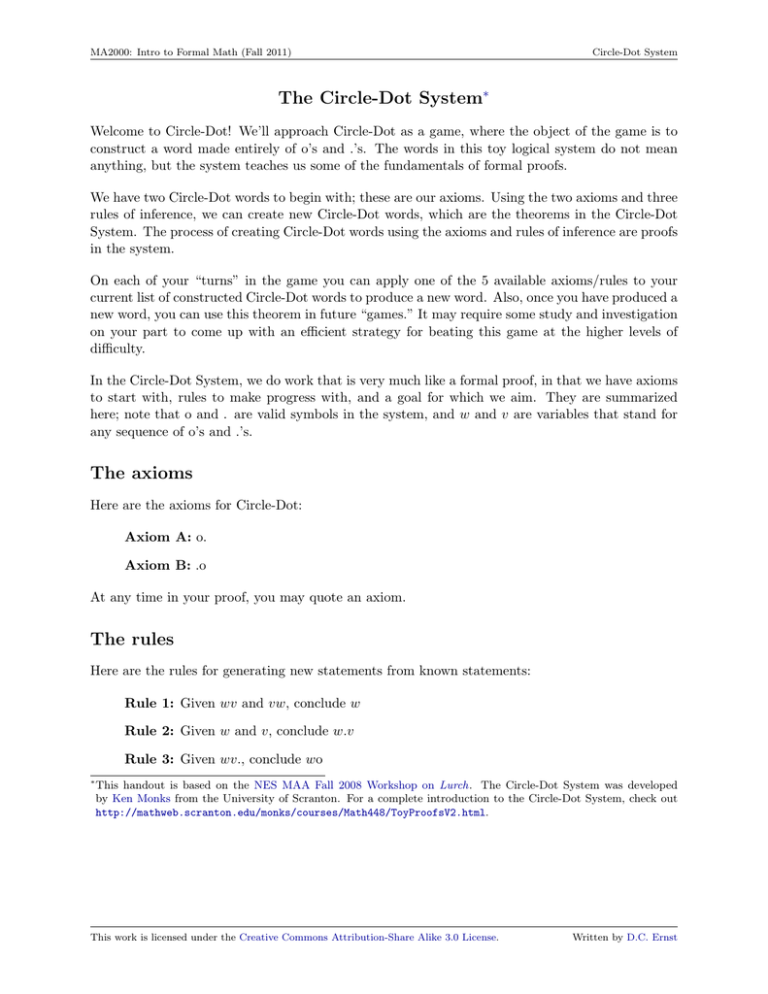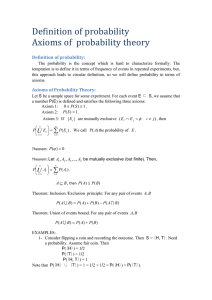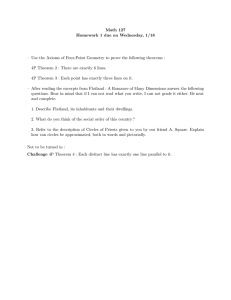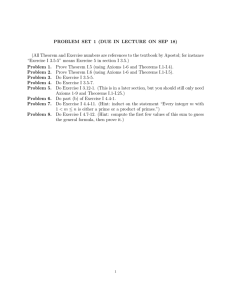Circle-Dot Handout
advertisement

MA2000: Intro to Formal Math (Fall 2011) Circle-Dot System The Circle-Dot System∗ Welcome to Circle-Dot! We’ll approach Circle-Dot as a game, where the object of the game is to construct a word made entirely of o’s and .’s. The words in this toy logical system do not mean anything, but the system teaches us some of the fundamentals of formal proofs. We have two Circle-Dot words to begin with; these are our axioms. Using the two axioms and three rules of inference, we can create new Circle-Dot words, which are the theorems in the Circle-Dot System. The process of creating Circle-Dot words using the axioms and rules of inference are proofs in the system. On each of your “turns” in the game you can apply one of the 5 available axioms/rules to your current list of constructed Circle-Dot words to produce a new word. Also, once you have produced a new word, you can use this theorem in future “games.” It may require some study and investigation on your part to come up with an efficient strategy for beating this game at the higher levels of difficulty. In the Circle-Dot System, we do work that is very much like a formal proof, in that we have axioms to start with, rules to make progress with, and a goal for which we aim. They are summarized here; note that o and . are valid symbols in the system, and w and v are variables that stand for any sequence of o’s and .’s. The axioms Here are the axioms for Circle-Dot: Axiom A: o. Axiom B: .o At any time in your proof, you may quote an axiom. The rules Here are the rules for generating new statements from known statements: Rule 1: Given wv and vw, conclude w Rule 2: Given w and v, conclude w.v Rule 3: Given wv., conclude wo ∗ This handout is based on the NES MAA Fall 2008 Workshop on Lurch. The Circle-Dot System was developed by Ken Monks from the University of Scranton. For a complete introduction to the Circle-Dot System, check out http://mathweb.scranton.edu/monks/courses/Math448/ToyProofsV2.html. This work is licensed under the Creative Commons Attribution-Share Alike 3.0 License. Written by D.C. Ernst MA2000: Intro to Formal Math (Fall 2011) Circle-Dot System Example Let’s try to prove the following theorem. Theorem C: . (just a single dot) At the moment, the only tools we have for getting started are the axioms. As we prove theorems, we’ll be able to incorporate them into our proofs, as well. To get started, let’s apply Axiom A and see what that gets us. Applying Axiom A, we get o. Looking at Rules 2 and 3, it should be moderately clear that they won’t help us get a single dot. So, perhaps Rule 1 will be useful, but to use it, we see that we need to have wv and vw. Let’s apply Axiom B and see if that helps at all. We get .o Now, if we let w=. and v=o wv = .o and vw = o. then Applying Rule 1, we can conclude that . holds. Okay, that was an informal discussion of what to do. Let’s write down something a little bit more formal. The following style of proof is called a line-numbered proof. Proof. 1. o. Axiom A 2. .o Axiom B 3. . Rule 1, lines 2 and 1 Some theorems Using Lurch, try to prove the following theorems using the axioms, rules, and any theorems you prove along the way. 1. Theorem D: o 2. Theorem E: ... 3. Theorem F: ..o 4. Theorem G: .oo 5. Theorem H: o..o 6. Theorem I: oooo 7. Theorem J: .o. 8. Theorem K: .ooo This work is licensed under the Creative Commons Attribution-Share Alike 3.0 License. Written by D.C. Ernst MA2000: Intro to Formal Math (Fall 2011) Circle-Dot System A question to ponder Is every finite length word of o’s and .’s a provable theorem in the Circle-Dot System? If you think the answer is yes, can you justify your answer? If you think the answer is no, can you come up with a string of o’s and .’s that you think cannot not be proven? This work is licensed under the Creative Commons Attribution-Share Alike 3.0 License. Written by D.C. Ernst




